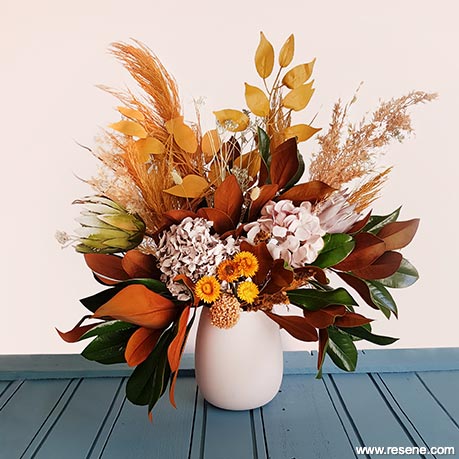From habitat magazine - issue 35, garden idea
Budding artists can go a step further than a still-life and paint the flowers themselves. Make your flowers last all year by drying blooms and painting them in beautiful Resene colours.

Dried floral arrangements are becoming popular – and painted dried floral arrangements even more so. Dried flowers and paint are a match made in heaven. Dried blooms painted in Resene paints last infinitely longer than a fresh posy and their fragrance can be topped up with a few drops of essential oil.
To get the best from your flowers, pick blooms (or foliage) with a low moisture content. How can you tell? If a plant feels somewhat ‘squishy’, it is likely to have more moisture. If it feels slightly dry to the touch, it will most likely dry well.
Plants that dry well include statice, gypsophila, artemisia (for its silver foliage), strawflowers (Helichrysum bracteatum), hydrangeas, proteas, honesty seed heads, lavender, celosia, eucalyptus foliage, craspedia, achillea, love lies bleeding (Amaranthus caudatus), roses, clematis seed heads, globe thistles and globe amaranth. These can all be grown in your garden. But think, too, of flowers and foliage that can be foraged. The charming bunny tails that grow close to beaches are perfect for a dried flower arrangement, as are the heads of toetoe or pampas grass. Seed heads can be striking too. Look for dried ‘architectural’ heads (think poppies, lotus and globe artichokes), which can be painted and displayed with poise and grace.
Pick your plants on a dry day and hang them upside down in a warm room away from direct sunlight. Avoid places that are damp or especially sunny – the colours of your flowers will diminish in full sun. Tie in small bundles to dry – larger bundles may encourage mould in the centre.
Once completely dry, lay out each flower singly on a drop cloth and, using a portable spray unit, paint the flowers and foliage your chosen colours. A portable spray unit is not absolutely necessary, but it is a lot easier for ‘busy’ flowerheads such as hydrangeas. Alternatively, you can place some paint in a wide, deep container and dip the flowerheads into it.
Use a small artist’s paintbrush to touch up any bare or hard-to-reach spots.
Hang the painted flowers to dry before arranging in a vase.
Choose a mix of different flowers – long and skinny flowerheads (such as lavender and salvias) mixed with big round blooms (such as hydrangeas and sunflowers). Play with different stem heights for effect but the whole arrangement, from top to bottom, should be two and a half times the height of the vase.
Hydrangeas are ideal for picking and drying, Plant in a partially shaded spot – they will grow in the sun, but their flowers will brown quickly in hot weather. Dig in plenty of compost before planting. Hydrangeas thrive in fertile soil. The best time to pick hydrangeas for drying is mid to late summer. They last longer in the vase than those picked earlier.
Words and image: Jane Wrigglesworth
Search habitat magazine stories
Printed copies of habitat highlights are available from late March 2024 at Resene ColorShops and resellers, while stocks last. You can view back issues of habitat magazine online.
Specifiers:
If you have an idea, project or story that you think would suit habitat, we’d love to hear from you. Please drop us an email with your details and include photos if submitting a project.
Sign up for a DIY card and Save! Australia | New Zealand